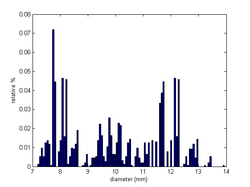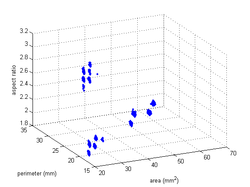Introduction
As it was explained in a previous post, we ask the reader to present both number and volume weighted distributions for a three-particle composed material, with the following settings:
- A-type: high-resolution elliptical particles with major-axe of 12 mm, AR=2
- B-type: high-resolution elliptical particles with major-axe of 10 mm, AR=3
- C-type: high-resolution elliptical particles with major-axe of 8 mm, AR=2
Use the Matlab’s microstructure generator to generate the samples with the 10% of the volume fraction of particles, lognormal size distribution with low dispersion (sigma= 0.05) and randomly oriented. If you wat to bypass the sample generation and the feature extraction steps you can directly download the objects’ features data files (A, B, C).

Results
When we represent an individual feature (maximum Feret, for example) for each object, we get the distribution in the image in where we can clearly differentiate the three contributions from each one of the three kinds of particles involved in the process.In addition we can also represent a scatter 3D plot in where the three classes are displayed well separated and clearly segmented.

Conclussions
An image processing analysis involves many different steps and each one of them is important and has a big influence in the final result. In order to get the best results the key consist of improving and optimizing every step as much as possible.
You can download the script of the statistical analysis from here.